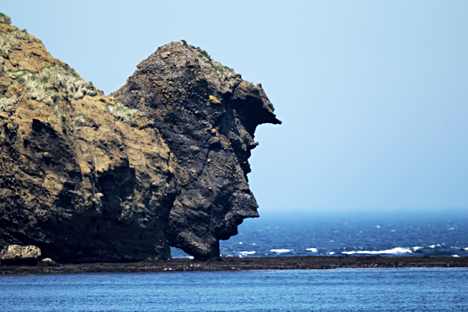
View of coastal rock formation, 'The Drinking Man', Urup Island. Source: ALamy / Legion Media
Alamy/Legion MediaIn recent years virtually no seismic activity has been recorded in the area of Russia's Kuril Islands and the Kamchatka Peninsula, as well as Hokkaido Island (Japan). As strange as this sounds, Russian seismologists find this worrying.
“The past year, as well as the six preceding years, was incredibly calm in terms of seismic activity,’’ Ivan Tikhonov, head of the seismology laboratory at the Institute of Marine Geology and Geophysics, told RBTH. “Such a quiet spell can only mean that enormous amounts of energy have accumulated below the surface, and this pent-up energy can set off several powerful earthquakes. We expect these tremors to occur over the next 18 months.’’
According to Tikhonov, an earthquake of at least 8.0 on the Richter scale is likely to hit near Urup Island in the southern part of the Kuril Islands somewhere between January 2016 and February 2017. Urup is in the epicenter of the seismically quiet zone. Furthermore, a 7.7 magnitude earthquake is also expected to hit near the northern Kuril Islands sometime before 2018. Another quake of 6.0 or 7.0 magnitude could hit the southern part of Sakhalin Island before the end of next spring.
Over 8,000 earthquakes of varying magnitude are detected in Russia yearly. More than half occur near the Kuril Islands and Kamchatka. The rest hit the Kola Peninsula, the Kaliningrad region, Crimea, the Caucasus, the Urals, Western Siberia, the Altai and the Sayan Mountains, the Pribaykalsky and Zabaykalsky districts, Sakhalin Island, the Commander Islands, the Yakutia Republic and the Arctic regions.
Russian researchers have used eight distinct earthquake prediction methods to base their conclusions, including the LURR theory (Load/Unload Response Ratio) – an approach which takes into account the influence of the Moon’s and the Sun’s gravitational forces on the Earth’s crust, as suggested by Chinese seismologists.
They also consider the Seismic gaps hypothesis developed by the Japanese seismologist, Kiyoo Mogi, which suggests powerful earthquakes are preceded by a period of no seismic activity in its future epicenter.
Scientists have also delved into research dealing with atmospheric jet streams, among other things.
All methods employed so far confirm the grim forecast, but there is always a possibility of error.
“Earthquakes originate deep beneath the earth, and scientists only have the results of surface observations,’’ said Mikhail Rodkin of the Institute of Earthquake Prediction Theory and Mathematical Geophysics. “It is a bit like if meteorologists only had data collected from wormholes.”
Over the past 20 years, the research group led by Ivan Tikhonov has been working on a fundamentally new method of short-term earthquake prediction, and their studies have yielded some results that will soon be presented.
Reports on credible earthquake predictions are sent by the Expert Board for Earthquake Prediction and Seismic Hazard Assessment to EMERCOM, the Russian state emergency services agency. In 2005, thanks to one such reliable forecast in the Kamchatka peninsula, EMERCOM deployed a rescue team that was prepared to act in the event of an earthquake in the region.
“Our method allows to detect imminent earthquakes that will happen in several days and does not produce too many false alarms,’’ Tikhonov said. ``But it should be used together with other medium-term prediction methods.”
Long-term forecast methods are considered the most efficient because the greater the timeframe the lower the likelihood of errors.
“Research on short-term earthquake forecast methods is underway in the U.S., Japan, New Zealand and Switzerland in the framework of the Collaboratory for the Study of Earthquake Predictability (CSEP), but these methods have yet to prove their efficiency,” said Vladimir Kosobokov, expert at the European Advisory Committee on Earthquake Prediction. Mr. Kosobokov doubts that the research by the Tikhonov team will yield any useful results.
The new method reportedly uses a mathematical algorithm based on a non-linear differential equation developed by Russian scientist Alexander Malyshev. So far, it has only been used to process data on earthquakes that occurred in Russia, Japan and Turkey. This led some experts to question its accuracy, and the doubts are exacerbated by the fact that the approach takes into account nothing but the seismic data from up to 24 hours before the earthquake.
All rights reserved by Rossiyskaya Gazeta.
Subscribe
to our newsletter!
Get the week's best stories straight to your inbox